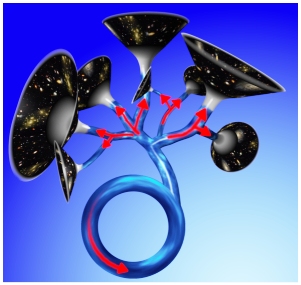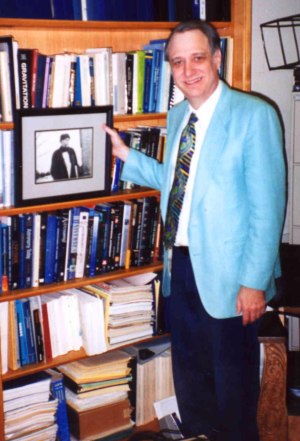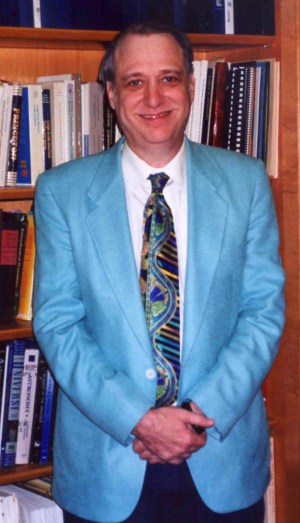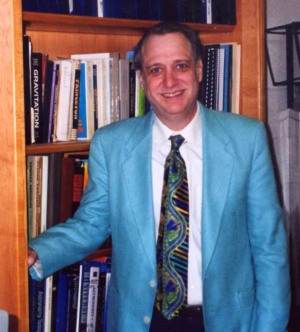
 |
Did you know
that we have already traveled in time? Do you know the longest time travel
so far?
We usually enjoy fantasies about time travel in science fiction movies and books. We are not even aware that the distinction between reality and fantasy is often quite vague. Meet the physicist who makes it even more blurred. J.Richard Gott, III, a professor of astrophysics at Princeton University is one of the leading cosmologists of our time and a person whose mind wonders about problems like the creation of the Universe and organizing high school science fairs. We spoke with him about the possibilities of time travel, how the Universe is its own mother, the significance of science fiction genre, why would somebody believe his theories in the first place, and why all of us should know more about science. |

Einstein showed in 1905 that the time travel to the future is possible within his theory of special relativity. According to the theory, clocks tick slowly and this has actually been observed. We observe that if we take atomic clocks on an airplane trip around the world toward the East, where the velocity of the plane adds to the rotation velocity of the Earth, these clocks come back about 59 nanoseconds slow. In fact, we observe that particles that are moving with speeds nearly the speed of light decay more slowly. So, if you wanted to visit the Earth in the year 3000, all you have to do is to get on a rocket ship going at 99.995% of the speed of light, go to a star 500 light years away, turn around and come back at that speed. When you get back, the Earth would be 1000 years older, but you would only aged 10 years. The biggest time traveler so far is an astronaut named Sergey Evdeyev, who was on the Mir Space Station for a total of 748 days on three space flights. When he returned to earth he had aged about a 1/50 of a second less that if he stayed home. That is, when he returned to earth he found the Earth a 1/50 of a second to the future than what he expected it to be.
Time travel to the past is more difficult but it is a theoretical possibility that seems to be allowed by Einstein's theory of general relativity. There, space and time are curved, and you can have solutions to those equations that are sufficiently twisted that allow you to circle back and visit an event in your own past. This is in the same way that Magellan's crew left from Europe, went steadily west, and circled the globe. There are solutions like this to Einstein's equations of general relativity: wormhole solutions, some that I found involve cosmic strings, and so forth. However, the question is whether these possibilities can be realized in our Universe or not. To understand that, we may need to understand the laws of quantum gravity. That is why gravity is particularly interesting project. We take solutions to Einstein's equations quite seriously because they have been tested. For example, light bending around the Sun and so forth. Therefore, the time travel to the past is a topic under current investigation.
Q: There are several universal questions that humankind has asked itself since the beginning of its time. One of them is about the beginning of everything, beginning of the Universe. You have an answer to this question, too.
We believe today that the Universe started after a state of very rapid expansion called inflation, back at the Big Bang. The Universe inflated very rapidly during this phase. This has been confirmed by recent observations of the cosmic microwave background, as the theory of inflation is made definite predictions of what we should have seen and they have been confirmed quite nicely. Professor Linde at Stanford has shown that if you have an inflating Universe like this that the quantum fluctuations cause it to create baby universes, like branches growing out of a tree. Each branch grows up to be as big as the trunk and it sprouts branches of its own. Thus, you have an infinite fractal tree of branching universes in this theory of inflation. You still might ask yourself the question, though, where did the trunk come from. Li-Xin Li and I proposed that simply one of the branches circles back around and grows up to become the trunk. This is a model where the Universe is its own mother. It is a model with a little time loop at the very beginning. This is a model that has quite interesting properties.
Q: Nevertheless, is it possible to test your theory of self-creating universe?

|
| The model of self-creating universe explains why we are constantly moving toward the future and never toward the past. On this sketch, our three dimensional world is represented as a two dimensional surface. The third dimension is used for showing the direction of time. An infinite number of universes grow out of the time loop. In that loop, a signal (red arrows) can travel only in one direction of time. This direction allows the signal to escape into the trunk with branches made of universes. A signal traveling in opposite direction would always end up in the loop, and would not be able to escape it. This would eventually destroy the loop. Therefore, a signal is not allowed to travel in the wrong direction in the first place. ( GIF animation - 766kb) |
In our model, there is a very simple explanation. The only way to have a self-consistent model in our case is if the light beams are only allowed to go toward the future. Any light beam going toward the future would go out one of these branches and just continue run out, no problem. But, a light beam going to the past go back down that branch, back down the branches, back into the trunk, and then it would circle this time loop an infinite number of times which would cause it to blow up and destroy it. This would not be the geometry you started with. In this time travel solution, you have to have a self-consistent solution where you are not killing your grandmother. The only way how to get a self-consistent solution is to have an arrow of time pointing away from the time loop at the beginning.
That was a very interesting and testable prediction that it had. In the future, one will have to see how this picture of our fits in whatever future superstring theory of everything. We think that it already fits in it very well conceptually because these branches originally had circumfereces that were very small and the superstring theory tells us that the big dimensions of space that we see used to be very tiny and curled up. And there are some curled up microscopic extra dimensions today that we don't see. The macroscopic dimensions that we see today are dimensions that used to be tiny as well. Thus, all of the dimensions in our Universe, all of the spatial dimensions were curled up in time. In our model, the time dimension is curled up in time as well. This is a little time loop at the beginning. We think it fits well into the superstring theory, but we will have to wait and see how that superstring theory close out and whether it allows solutions of this kind. We will have to see other predictions of the superstring theory that would convince you that it is the right theory.
 |
I think that science fiction is very interesting because a lot of times ideas are explored first in science fiction and then later by scientists as well. For example, H.G.Wells wrote the book "The Time Machine" in 1895. This is 10 years before the special relativity. At that time, with the Newton's theory, time travel looked impossible. But with the Einstein's theory of special relativity moving clocks tick slowly, and later, with the general theory of relativity, space and time are bendable. That is how a possibility of traveling in time came up. The same thing is true with the Carl Sagan's book "Contact" about wormholes. He asked Kip Thorne to examine whether his wormhole physics make sense. Then Kip Thorne looked into the wormhole physics seriously and found that circumstances and solutions like this might be possible. If you had wormholes like this, you might use them to make a time machine to visit the past. Thus, I think science fiction has often sparked interesting science investigations.
Q: What is your favorite science fiction book or movie?
I would have to say it is H.G. Wells' "The Time Machine". It is an amazing book and, as I said, 10 years or so ahead of its time.
Q: However, even the most of physicists cannot grasp the complexity behind your work. What can then an ordinary person expect?
I wrote a book "Time travel in the Einstein's Universe" about this. In the book, I am explaining my theory to the lay audience, too. Everyone should be able to understand this. Einstein's theory is about curved space-time, and this is very visual. You can understand the concept that space and time might be bent. You can visualize bending of a piece of paper. You can visualize a curved surface because you see the surface of the Earth. Many concepts of this can be explained rather simply. However, working out the equations for general relativity is difficult. Nonetheless, many of the solutions in general relativity that solved those equations are rather simple. The black hole solutions, for example, are beautiful. I think that the average person can understand what the implications of this theory are. I also go to some trouble to try to describe how Einstein came to some of these ideas.
Q: While everybody can appreciate and admire your work, most of humankind is struggling with very basic problems of daily survival. From their point of view, what would you say it is the importance of your work, except satisfying the human curiosity?
The first of all, the human curiosity is very important, because, as a species, we have been around for 200 thousand years. That is not remarkably long. Tyrannosaurs Rex existed for two and half million years, for example. However, in that very short time, one of the amazing things that we have accomplished is we really understood where we are in the Universe, we understood something about the laws of physics. That is what everybody should be proud of. Also, I think it is important to say that you never can tell quite what the implications of understanding science at a deep level would be. Einstein was trying to understand the basic laws of physics and the Universe. Well, one of the things that came out of that is E=mc2, which is nuclear energy. One cannot often foresee that understanding science may have profound applications for the future of the human race. And I think one other thing that we should be doing as a human race is going to other planets, colonizing every world. This would be a benefit to our survival. This is something that you need science and technology to do. If we stay on the Earth we are subject to extinction events as other species are, and our survival chances to spread out into the Universe would improve.
 |
The important thing that is stressed in that kind of competition is that high school students can actually do research. They do research projects, and they enter these research projects. We think that one of the best ways to find science talent is to actually encourage high school students to do their own research. Students in high school can actually do many frontier research projects. They may work for the scientists at a university, but many projects people can do in their own basement. A lot of science is learning about it by doing it. I teach a course in general relativity for undergraduates, and I think the Einstein's theory of general relativity, should be something that is on the undergraduate curriculum for physic students. It shouldn't necessarily be put off to graduate school. I think high school students should certainly be exposed to the ideas of special relativity and general relativity because TIME magazine picked Einstein as the person of the century. Thus, if you want to be an educated person, you should understand what Einstein did, why he is there.
Q: Why do kids need these scary science classes if just a small number of them will become scientists?
First of all, I would describe science classes as fun, not scary. I think that exposure of high school students to science is important. Science is a part of our modern world. It is one of the things that human beings have discovered. Just as in high school, you ought to read some Shakespeare because he is one of the important people who have written wonderful plays. That is why I think you should know something about science. You should know something about science to understand our modern world. If you are going to be a politician, you may have to decide scientific questions. If you are going to run a business, scientific considerations may come into some decisions that you have to make on the future of your company, whether to use some technology or not and why. Therefore, I think science education is a part of our educational system. That is something that people would find very worthwhile.
Dejan
Vinkovic (Copyright: Vjesnik
and znanost.org) 2002.
